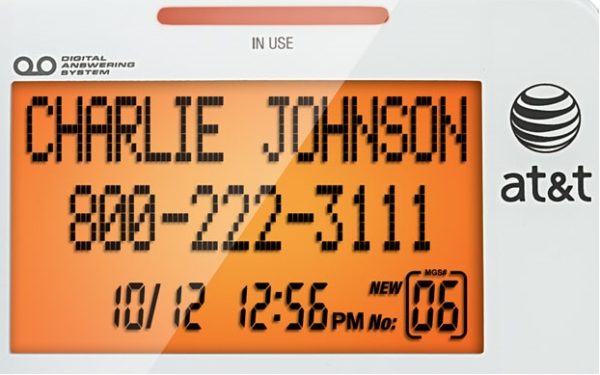Can phone spoofing in Canada be stopped?

 The phone rings. An unfamiliar voice is on the other end.
The phone rings. An unfamiliar voice is on the other end.
“Yeah, uh, I got a call from this number…”
Except you didn’t call. There is no record of a call from your phone: you’ve been “spoofed”.
Call spoofing, a practice in which someone uses technology to display a telephone number that is not their own, is a growing phenomenon worldwide. While the act can come across as harmless teenage horseplay, there is a dark side to it.
The prank variety of spoofing is placing a strain on emergency response services. The practice is also used by internationally based telemarketers who count on fact that people are more likely to pick up a local number than an international one. Then there is the shadowy professional organized crime variety is enabling fraud, data theft, even “virtual abduction”.
In 2007, a Washington teenager named Randal Ellis placed 185 calls to 911 support centres in the United States. In one instance, his tall tale sent the Orange County Sheriff’s department SWAT team to an unsuspecting house expecting a scene of drug abuse and murder. Instead, an innocent husband and wife ended up in handcuffs. Ellis was ultimately sentenced to three years in prison.
For most of us, call spoofing is an easily forgotten annoyance. But for some it has the potential to hit them in the pocket book. Last year, a Windsor business had its number spoofed by a company trying to pitch duct cleaning.
“I had one gentleman that I talked to this morning, he had 22 calls from us, from my number. He was livid,” said Jim Gibbs, owner of an auto parts store called Starters Powerhouse.
Gibbs said those receiving the annoying calls took their ire out on him.
“It’s a stressful situation when you get hundreds of people calling you back and asking you why you called. Just imagine your cell phone or any phone at home where constantly it rings, you pick it up and it’s why did you call me.”
Call spoofing went mainstream in 2004 with the launch of a website called Star38.com, which allowed calls to be easily spoofed online. Although the company stopped offering the service a year later, numerous copycats sprang up.

There are several ways a call can be spoofed. The first is through an analog telephone adapter or SIP phone, which can be employed by using a carrier that doesn’t block subscribers out of hardware configuration settings. Others work through calling cards that allow the purchaser to choose a display number. But most of the time, caller i.d spoofing is done through simple web services, some of which offer a free trial, the ability to change the pitch of your voice, and a soundboard.
More than two decades ago the CRTC gave the green light to Canadian telecom companies, allowing them to introduce call display so long as they simultaneously introduced call display blocking.
But, to date, no actions have been taken to outlaw call spoofing and curb the very real dangers it represents.
Phone spoofing is, surprisingly, not illegal in Canada
“It’s legal, but in our opinion it should be illegal,” says Chris Gerritsen, a Telus spokesperson.
In the U.S., however, that is not the case.
On December 22, 2010, President Obama signed the the Truth in Caller ID Act of 2009 bill into law. The law makes it illegal “to cause any caller identification service to knowingly transmit misleading or inaccurate caller identification information with the intent to defraud, cause harm, or wrongfully obtain anything of value….”
For now, the CRTC says Canadians can report call spoofing to the Canadian Anti Fraud Centre. But that course of action didn’t work for some victims of recent scams in B.C. and Saskatchewan, who received calls from what they thought was B.C. Hydro and SaskEnergy, pitching cash gift cards or demanding an immediate credit card payment for an overdue bill.
Most of the telemarketing scams that employ call spoofing presumably come from off shore, which would make legislation against them a game of catch up, if not an entirely futile endeavor.
The CBC program Marketplace got hidden cameras into a call centre in Pakistan that was using call spoofing to try and sell air duct cleaning services to Canadians. They captured footage of a supervisor assuring employees that they could not be caught.
“There is no need to worry,” said the man. “The customer will not be able to report us. They can’t trace us.”
While the CRTC admits it is basically helpless in dealing with international call spoofing, there is one simple tactic Canadians can use if someone is asking for money over the phone: call them back. For now, individual companies are left to communicate to their customers about the practice.
“We will absolutely never ask for payment information over the phone,” says SaskEnergy spokeswoman Casey MacLeod. “Certainly, if someone is asking for payment, that’s not us — it’s definitely not us!”
Nick Waddell
Founder of Cantech Letter
Cantech Letter founder and editor Nick Waddell has lived in five Canadian provinces and is proud of his country's often overlooked contributions to the world of science and technology. Waddell takes a regular shift on the Canadian media circuit, making appearances on CTV, CBC and BNN, and contributing to publications such as Canadian Business and Business Insider.
